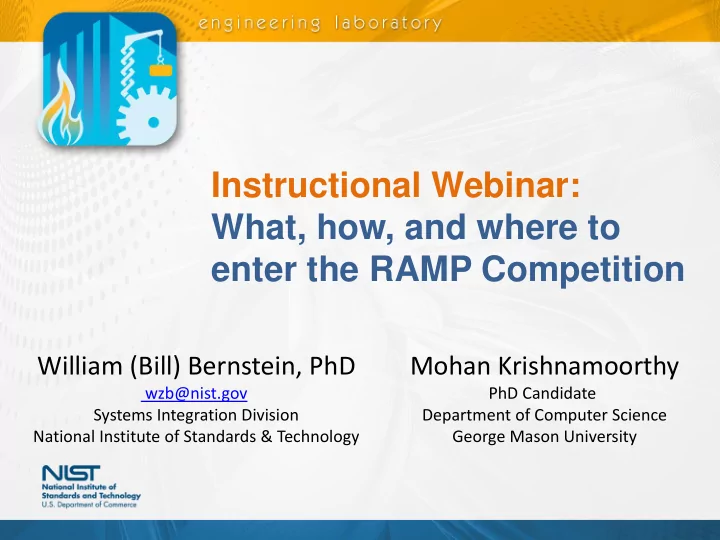

Instructional Webinar: What, how, and where to enter the RAMP Competition William (Bill) Bernstein, PhD Mohan Krishnamoorthy wzb@nist.gov PhD Candidate Systems Integration Division Department of Computer Science National Institute of Standards & Technology George Mason University
Visit challenge on-line! https://www.challenge.gov/challenge/ramp-reusable- abstractions-of-manufacturing-processes/ 2
If you have questions…. • Live participants: use the Q&A chat bar • After the webinar, send any other questions to – Swee Leong, swee.leong@nist.gov – Bill Bernstein, wzb@nist.gov 3
ASTM International: Committee E60 on Sustainability Scope: The acquisition, promotion, and dissemination of knowledge, stimulation of research and the development of standards relating to sustainability and sustainable development. http://www.astm.org/COMMITTEE/E60.htm Subcommittee E60.13 on Sustainable Manufacturing 4
ASTM E2986-15: Standard Guide for Evaluation of Environmental Aspects of Sustainability of Manufacturing Processes • Designed to complement: – ISO 14000 (environmental management) – ISO 50000 (energy management) • Provides guidelines for the collection and analysis (e.g. decision making processes) of manufacturing data • New Appendix (up for ballot) demonstrates its use through a machining case study. https://www.astm.org/Standards/E2986.htm 5
ASTM E3012-16: Standard Guide for Characterizing Environmental Aspects of Manufacturing Processes • Designed to complement ASTM E2986-15 • Provides guidelines for the formal characterization and representation of unit manufacturing process (UMP) models • Fundamental foundation for the idea of a repository of reusable UMP models https://www.astm.org/Standards/E3012.htm 6
Goals of ASTM E3012-16 • Consistently characterizing manufacturing process models • Sharing and re-using manufacturing process information • Promoting integration of tools for manufacturing-related decision-making • Aiding environmental sustainability assessment 7
Goals of RAMP Competition • Model any unit manufacturing process of interest • Demonstrate ASTM E3012-16 on a variety of unit manufacturing processes (UMPs) • Demonstrate the use of a reusable standard format leading to models suitable for system analysis, such as – simulation modeling or – as an optimization program. 8
The “When” - Important Dates Submission Deadline: March 20, 2017 @ 5pm ET Announcement of Finalists: April 17,2017 (by e-mail) Announcement of Winners: June 4-8, 2017 ASME 2017 MSEC Los Angeles, CA 9
The “Who” • Can be teams or individuals • Person accepting prize must be US citizen or permanent resident 10
What to submit? 1. Graphical Representation 2. Transformation Function(s) 3. Description of Nomenclature 4. Description of Information Sources 5. README Section 6. Written Narrative 11
1) Graphical Representation Product/Process Information Equipment and material specifications Production plans Process Specifications Quality plans Setup-operation-teardown instructions KPI’s and quality plans Control Programs and process control PLM and sustainability plans Product and engineering specifications Safety documentation Part geometries Transformation Energy Input Output Material Energy Product Information Material & consumables By-Product Outside factors Waste Resources Disturbance Solid, liquid, emission Equipment Thermal, noise Tooling Feedback Fixtures Human Software 12 Figure based on ASTM E3012-16. Standard available for competition participants.
1) Graphical Representation - Example Variable definitions for transformation equations (short list) Product & Process Information 𝑉 𝑞 − Specific Cutting Energy (W/mm 3 ) 𝑞 𝑛 − Milling Power (kW) Job Information 𝑊 𝑗 − volume of input (mm 3 ) 𝑓 𝑛 − Milling Energy (kJ) Part Description: Heat Sink Test Part 𝑊 − Cutting Speed (m/min) 𝑔 𝑢 − Feed per tooth (mm/tooth) Geometry: Complex, see CAD file (file.stp) 𝑢 𝑏_𝑝 − Approach and Overtravel time (sec) 𝑊𝑆𝑆 − Volume Material Removal Rate (mm 3 /min) Material: Al6061 𝑢 𝑠 − Retract time (sec) 𝑀 𝑑 − Extent of the first contact (mm) Operations: Mill thicknesses, 𝑢 ℎ − Handling Time (sec) 𝑢 𝑛 − Milling Time (sec/cut) 𝑢 𝑗 − Milling Idle time (sec) bosses and counter bores, 𝐹 − Total energy consumed (kWh/cycle) 𝑞 𝑗 − Milling Idle power (kW) deburr, mill chamfers, radii, mill fins 𝐷 – Total cost for energy ($) Required Tools: End mills, chamfer mills, rounding mills 𝑓 𝑗 − Milling Idle Energy (kJ) 𝐷𝑃 2 − Total CO 2 for energy (kg) 𝑓 𝑑 − Energy Consumed per cycle (kJ/cycle) 𝑢 𝑢 − Total time for all cycles (sec) 𝑢 𝑑 − Total time per cycle (sec) 𝑍𝑗𝑓𝑚𝑒 − Items produced in all cycles (qty) Transformation Equations 𝑓 𝑛 = 𝑞 𝑛 ∗ 𝑢 𝑛 𝑊 = 𝑂 ∗ 𝐸 ∗ 1000𝜌 𝑔 𝑢 = 𝑔 𝑠 (𝑂 ∗ 𝑜 𝑢 ) Τ 𝑊𝑆𝑆 = 𝑥 𝑛 ∗ 𝑒 ∗ 𝑔 𝑓 𝑗 = 𝑞 𝑗 + 𝑢 𝑗 𝑞 𝑗 = 𝑞 𝑡 + 𝑞 𝑑 + 𝑞 𝑏 𝑠 Outputs Inputs For centered milling: 𝑓 𝑑 = 𝑓 𝑛 + 𝑓 𝑗 + 𝑓 𝑐 𝑢 𝑑 = 𝑢 𝑚 + 𝑢 𝑑 + 𝑢 𝑣 + 𝑢 𝑗 Τ 𝑀 𝑑 = 𝐸 2 Finished part, qty Electrical energy, kWh 𝑢 𝑢 = 𝑢 𝑑 ∗ 𝑜 𝑑 𝑊 𝑗 = 𝑚 𝑛 ∗ 𝑥 𝑛 ∗ ℎ 𝑛 ∗ 𝑜 𝑑 Waste For peripheral milling: Workpiece material 𝑢 𝑛 = 60 ∗ 𝑚 𝑛 +𝑀 𝑑 𝑍𝑗𝑓𝑚𝑒 = 𝑜 𝑑 Heat, BTU 𝑢 𝑏_𝑝 = 60 ∗ 𝑒 𝑏 +𝑒 𝑝 (e.g. aluminum, steel) 𝑔 𝑔 𝑠 Material, kg 𝑠 𝐷 = 𝐹 ∗ 𝐷 𝑙𝑥ℎ 𝑀 𝑑 = 𝑒 ∗ (𝐸 − 𝑒) 𝑞 𝑛 = 𝑊𝑆𝑆∗𝑉 𝑞 1000 For face milling: 𝐷𝑃2 = 𝐹 ∗ 𝐷𝑃2 𝑙𝑥ℎ 𝑢 ℎ = 𝑢 𝑏_𝑝 + 𝑢 𝑠 𝑢 𝑛 = 60 ∗ 𝑚 𝑛 +2∗𝑀 𝑑 𝑔 𝐹 = 𝑓 𝑑 ∗ 𝑜 𝑑 ∗ 2.78𝑓 −4 𝑠 𝑢 𝑗 = 𝑢 ℎ + 𝑢 𝑛 𝑀 𝑑 = 𝑥 𝑛 ∗ (𝐸 − 𝑥 𝑛 ) Resources Operator: John Doe Tool List: (1) 1/4" Dia. 2 Flute Stubby Fullerton E.M. (2) 3/16" Dia. 2 Flute Stubby Fullerton E.M. Machine: GF Agile HP600U (3) 3" Face Mill Fixture Details: Mill Clearance, Drill, Ream and Tap Mounting (4) 1/2" Dia. 2 Flute Stubby Fullerton E.M. Holes Orientation, Origin (0.100,0.720,0.168) (5) 1/4" x 45° Chamfer Mill Software: See MasterCam for fixture and tooling specifics (6) 1/4" 2 Flute E.M. With .020" x 45° Chamfers (7) 1/4" x .093" Corner Rounding E.M. 13
Recommend
More recommend